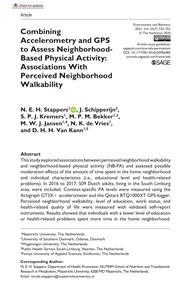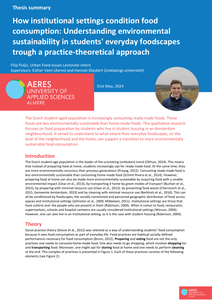This study explored associations between perceived neighborhood walkability and neighborhood-based physical activity (NB-PA) and assessed possible moderation effects of the amount of time spent in the home neighborhood and individual characteristics (i.e., educational level and health-related problems). In 2016 to 2017, 509 Dutch adults, living in the South Limburg area, were included. Context-specific PA levels were measured using the Actigraph GT3X+ accelerometer and the Qstarz BTQ1000XT GPS-logger. Perceived neighborhood walkability, level of education, work status, and health-related quality of life were measured with validated self-report instruments. Results showed that individuals with a lower level of education or health-related problems spent more time in the home neighborhood. The perceived neighborhood walkability only affected NB-PA for individuals spending a relatively large amount of time in their home neighborhood. PA-facilitating features in the home neighborhood, for example, aesthetics, were only associated with more NB-PA for individuals without health-related problems or with a higher level of education.
DOCUMENT

Objectives: Promoting unstructured outside play is a promising vehicle to increase children’s physical activity (PA). This study investigates if factors of the social environment moderate the relationship between the perceived physical environment and outside play. Study design: 1875 parents from the KOALA Birth Cohort Study reported on their child’s outside play around age five years, and 1516 parents around age seven years. Linear mixed model analyses were performed to evaluate (moderating) relationships among factors of the social environment (parenting influences and social capital), the perceived physical environment, and outside play at age five and seven. Season was entered as a random factor in these analyses. Results: Accessibility of PA facilities, positive parental attitude towards PA and social capital were associated with more outside play, while parental concern and restriction of screen time were related with less outside play. We found two significant interactions; both involving parent perceived responsibility towards child PA participation. Conclusion: Although we found a limited number of interactions, this study demonstrated that the impact of the perceived physical environment may differ across levels of parent responsibility.
MULTIFILE

The nursing home is often a final stage in the living career of older persons, but the question remains whether it is a true home or merely a place where care is provided for the residents. This study investigates the sense of home and its constituent factors among both permanent and temporary residents of nursing homes in The Netherlands. A qualitative research design was chosen for the study, which consisted of in-depth interviews using a topic list that was developed through literature review and a focus group session. Autonomy and safety and security are the basic aspects for a sense of home. These aspects refer to the relationships and actions of nursing home residents and the environment in which people live. The research findings show that developing a sense of home encompasses much more than just being surrounded by personal belongings and having a private room with certain facilities. Subjective components of relationships and (inter)actions are as important as the physical component of living and housing. Only when a right balance is achieved between all factors, a true sense of home, albeit away from the familiar home someone spent most of his/her life, can be developed. Understanding these perspectives and needs can contribute to a better design and retrofitting process of future nursing homes.
DOCUMENT

An activity-friendly environment may increase physical activity (PA) levels and decrease sedentary behavior (SB). This study investigated associations between socio-demographic characteristics, health-related quality of life (HRQoL), perceived environment and objectively measured PA outcomes. Socio-demographic characteristics were assessed using a questionnaire and HRQoL was measured using the EQ-5D. The Neighborhood Environment Walkability Scale (NEWS-A) was used to assess the perceived environment. SB, light PA (LPA) and moderate-to-vigorous PA (MVPA) were measured using the Actigraph GT3X+. Data from 622 Dutch adults were used in multivariate linear regression analyses to investigate associations between NEWS-A and PA outcomes. Analyses were controlled for socio-demographic characteristics and HRQoL. The presence of attractive buildings was associated with less SB ( = ?0.086, p < 0.01) and more MVPA ( = 0.118, p < 0.01). Presence of destinations within walking distance was also positively associated with MVPA ( = 0.106, p < 0.01). Less crime was associated with less MVPA ( = 0.092, p < 0.05). Interactions between personal and environmental characteristics showed that the absence of PA-hindering characteristics (e.g., heavy traffic) was associated with less SB and more MVPA, but only for residents with problems regarding pain and usual activities. The presence of PA-facilitating characteristics (e.g., aesthetics and destinations) was associated with less SB, more LPA and more MVPA but only for the more advantaged people in society. Results suggest that to reduce health inequalities, it would be more helpful to remove barriers rather than introduce PA facilitating characteristics.
DOCUMENT

Technology and architectural solutions are needed as a means of support in future nursing homes. This study investigated how various monodisciplinary groups of stakeholders from healthcare and technology envision the nursing home of the future and which elements are necessary for its creation. Moreover, differences in needs and interests between the various stakeholders were considered. This qualitative study gathered data via 10 simultaneous sticky note brainstorm sessions with 95 professional stakeholders, which resulted in 1459 quotes in five categories that were clustered into themes and processed into word clouds. The stakeholders prioritized the needs of the resident and placed the most importance on the fact that a nursing home is primarily a place to live in the final stages of one's life. A mix of factors related to the quality of care and the quality of the built environment and technology is needed. Given the fact that there are differences in what monodisciplinary groups of stakeholders see as an ideal nursing home, multidisciplinary approaches should be pursued in practice to incorporate as many new views and stakeholder needs as possible.
DOCUMENT

Background: Concepts such as participation and environment may differ across cultures. Consequently, to use a measure like the Participation and Environment Measure for Children and Youth (PEM-CY) in other than the original English-speaking contexts, cultural adaptation needs to be assured. The aim of this study was to cross-culturally translate and adapt the PEM-CY into German as it is used in Germany, Austria and Switzerland. Methods: Fifteen parents of children and adolescents with disabilities from three German speaking countries participated in three rounds of think-aloud interviews. We followed the procedure of cultural equivalence guidelines including two additional steps. Data was analyzed by content analysis using semantic, idiomatic, experiential and conceptual equivalence. Results: Results show adaptations mainly focused on experiential and conceptual equivalence, with conceptual equivalence being the most challenging to reach. Examples of experiential equivalence included adapting the examples of activities in the PEM-CY to reflect those typical in German speaking countries. Conceptual equivalence mainly addressed aspects of “involvement” and “environment” of children and adolescents and was reached through adaptations such as enhanced instructions and structures, and additional definitions. Conclusions: This study presents a cross-cultural translation and adaptation process to develop a German version of the PEM-CY that is suitable for Germany, Austria and Switzerland. Using a modified cultural adaptation process, a culturally adapted version of PEM-CY (German) is now available for research, practice and further validation.
DOCUMENT

This study explores how households interact with smart systems for energy usage, providing insights into the field's trends, themes and evolution through a bibliometric analysis of 547 relevant literature from 2015 to 2025. Our findings discover: (1) Research activity has grown over the past decade, with leading journals recognizing several productive authors. Increased collaboration and interdisciplinary work are expected to expand; (2) Key research hotspots, identified through keyword co-occurrence, with two (exploration and development) stages, highlighting the interplay between technological, economic, environmental, and behavioral factors within the field; (3) Future research should place greater emphasis on understanding how emerging technologies interact with human, with a deeper understanding of users. Beyond the individual perspective, social dimensions also demand investigation. Finally, research should also aim to support policy development. To conclude, this study contributes to a broader perspective of this topic and highlights directions for future research development.
MULTIFILE

This paper outlines the main differences between ecocentric and anthropocentric positions in regard to justice, exploring university students’ perceptions of the concepts of social and ecological justice and reflecting on how values assigned to humans and the environment are balanced and contested. Putting justice for people before the environment is based on evidence that biological conservation can disadvantage local communities; the idea that the very notion of justice is framed by humans and therefore remains a human issue; and the assumption that humans have a higher value than other species. Putting justice for the environment first assumes that only an ecocentric ethic guarantees protection of all species, including humans, and therefore ecological justice already guarantees social justice. This research shows that many students emphasize the convergence of social and ecological justice where human and environmental interests correspond. While not wishing to diminish the underlying assumptions of either ethical orientation, the common “enemy” of both vulnerable communities and nonhuman nature, as identified by students, is an ideology of economic growth and industrial development. http://dx.doi.org/10.13135/2384-8677/2688 LinkedIn: https://www.linkedin.com/in/helenkopnina/
MULTIFILE

Background: Concepts such as participation and environment may differ across cultures. Consequently, to use a measure like the Participation and Environment Measure for Children and Youth (PEM-CY) in other than the original English-speaking contexts, cultural adaptation needs to be assured. The aim of this study was to cross-culturally translate and adapt the PEM-CY into German as it is used in Germany, Austria and Switzerland. Methods: Fifteen parents of children and adolescents with disabilities from three German speaking countries participated in three rounds of think-aloud interviews. We followed the procedure of cultural equivalence guidelines including two additional steps. Data was analyzed by content analysis using semantic, idiomatic, experiential and conceptual equivalence. Results: Results show adaptations mainly focused on experiential and conceptual equivalence, with conceptual equivalence being the most challenging to reach. Examples of experiential equivalence included adapting the examples of activities in the PEM-CY to reflect those typical in German speaking countries. Conceptual equivalence mainly addressed aspects of “involvement” and “environment” of children and adolescents and was reached through adaptations such as enhanced instructions and structures, and additional definitions. Conclusions: This study presents a cross-cultural translation and adaptation process to develop a German version of the PEM-CY that is suitable for Germany, Austria and Switzerland. Using a modified cultural adaptation process, a culturally adapted version of PEM-CY (German) is now available for research, practice and further validation.
DOCUMENT

The Dutch student-aged population is increasingly consuming ready-made foods. These foods are less environmentally sustainable than home-made foods. This qualitative research focuses on food preparation by students who live in student housing in an Amsterdam neighbourhood. It aimed to understand to what extent their everyday foodscapes, on the level of the neighborhood and the home, can support a transition to more environmentally sustainable food consumption. This is a thesis summary.
DOCUMENT
